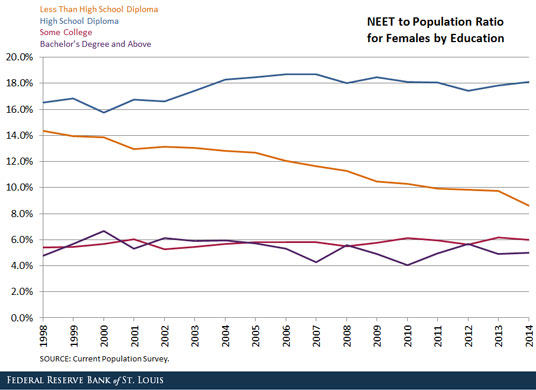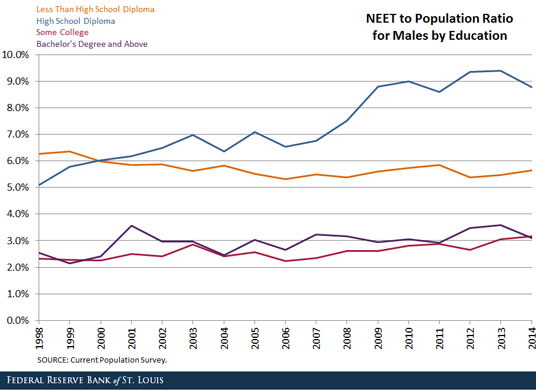Trends in Youth Not in Education, Employment or Training
The labor force participation rate for workers 16 to 24 years old has been falling, and this news isn’t necessarily bad, as it has been accompanied by a rise in attending school. However, a rise in another subset of this age group could be a cause for concern, especially when digging even deeper into who may be affected.
The group in question is characterized as NEET, or people ages 16 to 24 who are “not in education, employment or training.” The definition is straight forward, but in most cases reflects disengagement from the labor market and perhaps from society in general. A 2012 study from the European Foundation for the Improvement of Living and Working Conditions found that spending time as NEET may lead to a wide range of social disadvantages such as insecure and poor future employment, criminal behavior, and mental and physical health problems.1
The study, which looked at European data, found that some young people were at greater risk of being NEET than others. Those with low levels of education in Europe were three times more likely to be NEET compared to those with postsecondary education, while young immigrants were 70 percent more likely to become NEET than nationals. The same study estimated that the economic loss due to the disengagement of young people from the labor market in 2011 was 153 billion euros, or 1.2 percent of the European gross domestic product.
With the observed decline in labor force participation, the concern about NEET increased in recent years in the U.S. as well. In a recent Regional Economist article, my co-authors and I studied American youth not participating in the labor market. We found that since 1998 the total fraction of NEET increased less than the fraction of young people attending school. However, the increase in overall NEET hid significant heterogeneity across education groups. Differences are very important by gender as well, with a significantly higher fraction of women in NEET than men.2

As the above figure shows, the share of NEET women has decreased from 10.7 percent in 2007 to 9.9 percent in 2011, continuing its declining trend since 2005. On the other hand, the fraction of NEET men was stable until 2007 and has been increasing since then. While 4.8 percent of men ages 16-24 were NEET in 2007, the fraction reached 5.6 percent in 2010 and has remained stable since then.


Men with less education have been the ones increasing their incidence of NEET the most. Previously, we found that young people with less than a high school diploma increased their school attendance, but that was not the case for the population with a high school degree. The figure above shows that males with a high school degree increased their NEET fractions during and after the Great Recession, going from 6.8 percent in 2007 to 9.0 percent in 2010 and a peak of 9.4 percent in 2013.
This latter group is the one reflecting a similar scenario as in the European case, and therefore the one that should be studied more carefully to avoid their disengagement from the labor market and society in general.
Notes and References
1 Mascherini, Massimiliano; Salvatore, Lidia; Meierkord, Anja; and Jungblut, Jean-Marie. “NEETs—Young People Not in Employment, Education or Training: Characteristics, Costs and Policy Responses in Europe.” European Foundation for the Improvement of Living and Working Conditions, Oct. 21, 2012.
2 The data do not include reasons for being NEET, so we cannot examine the reasons more women are NEET than men.
Additional Resources
- Regional Economist: Youth Labor Force Participation Continues To Fall, but It Might Be for a Good Reason
- On the Economy: Lack of Hires Had Larger Effect on Labor Market in Recession Than Separations
- On the Economy: How Have Labor Market Flows Changed Since the Great Recession?
Citation
Maria E Canon, ldquoTrends in Youth Not in Education, Employment or Training,rdquo St. Louis Fed On the Economy, Feb. 9, 2015.
This blog offers commentary, analysis and data from our economists and experts. Views expressed are not necessarily those of the St. Louis Fed or Federal Reserve System.
Email Us
All other blog-related questions

